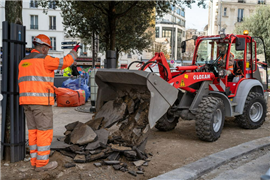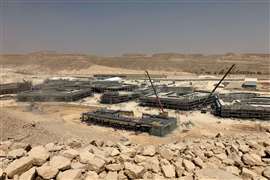Emissions impetus in compact equipment
29 January 2014

This year sees a further step in exhaust emissions requirements for diesel engines used in off-highway machines. These will have a limited impact on compact construction equipment in the US and Europe, but they are still translating to plenty of new machine launches.
For smaller engines – less than 55 kW, the standards that have to be met are already in force. In Europe there is no new requirement for these smaller units, with emissions legislation stopping some years ago at the Stage IIIA or Stage IIIB level. In the US, requirements for these engine sizes came into force a little later, but are essentially in place.
However, the flexibility provisions and other allowances to help manufacturers make a smooth transition from one tier of regulations to the next, mean that even though laws for sub
56 kW engines may have been in place for a while, machines with these engines fitted may only just be coming onto the market.
As far as compact equipment is concerned, the new requirements for
56 kW+ engines will not hit too many of the more popular sizes of machines in Europe and the US. You would be hard-pushed to find a 56 kW engine in anything smaller than about a 10 tonne excavator, for example.
Similarly, compact wheeled loaders – machines with a 1 m3 standard bucket capacity or less – would tend to have engines around or below 55 kW. Whether the laws impact on these products depends a little on how you define ‘compact’.
Skid steer loaders and compact tracked loaders are a little different – machines with about a 1 tonne or greater rated capacity would need something more powerful than 55 kW in a lot of cases. That would cover what many people would describe as large skid steer and compact tracked loaders, which can offer capacities of well over 1.5 tonnes.
The need for lower exhaust gas emissions can mean more components in the engine compartment. This in itself is quite a headache for machine designers as they to try to fit these bulky packages in without adding to the overall machine size or impeding visibility for the operator.
There will be knock-on consequences for owners and operators. More components naturally raise the purchase price of machines, and in the competitive compact sector any price increase will be keenly felt. More components also means more servicing requirements, such as periodically having diesel particulate filters (DPFs) cleaned, or keeping diesel exhaust fluid (DEF) – products such as AdBlue – topped up for selective catalytic reduction (SCR) systems.
However, iC has not found any examples of compact machines using AdBlue. The main emissions control technologiesi these classes of machine are in-engine systems like exhaust gas recirculation, along with exhaust aftertreatment systems like DPFs.
The flip side of this of course is that manufacturers can set themselves apart by producing machines with engines that do not require aftertreatment systems.
Bobcat for example has releases its first Tier 4 loaders with seven medium sized skid steer and tracked, machines in the most popular classes featuring engines without diesel particulate filters.
Built around its 500-series frame, the machines in question are the S510, S550 and T550 radial lift path loaders, which are suited to digging and dumping applications, and the S530, S570, S590 and T590 vertical lift path models, which are better for loading at height.
These machines offer rated capacities up to 998 kg, and come with several new features such as a machine protection system that monitors, manages and shuts down the engine if there is a problem like coolant or oil temperatures getting too high. Meanwhile, a cold weather protection system limits maximum engine revs to prevent damage if oil temperatures are too low.
Reduced tail swing
In the excavator segment meanwhile, Bobcat has two new machines in the shape of the 6 tonne class E62 and 8 tonne class E85 reduced tail swing (RTS) models, which replace the E60 and E80.
Power for both comes from a Yanmar engine, with the 44.3 kW unit in the E85 offering +10% more power than was available in the E80. EGR and a DPF are used to meet exhaust emission requirements, and Bobcat also said there had been big improvements in fuel efficiency over the previous model.
Both excavators feature upgraded hydraulic systems resulting in higher pressures and flows, generating smoother and greater digging and lifting performances.
The new E62 compact excavator offers a +10% increase in the arm digging force to 28.7 kN and an +8% increase in the bucket digging force to 43.1 kN in the short arm version. In the E85 model, the bucket digging force has been increased to 61.8 kN, a +13% increase over the previous model.
The low exhaust emissions and external noise levels (97 and 98 dBA in the E62 and E85, respectively) mean the excavators could be used sensitive areas, or at night. The cab meanwhile offers low operator noise levels of 73 and 71 dBA, respectively.
Dual brand
As they occupy the grey area between mini and full-sized excavators, the excavators are also available in the orange livery of Bobcat’s parent company and sister-brand, Doosan. They are designated the DX62R-3 and DX85R-3 in Doosan’s nomenclature. Also new in the range is the DX63-3, a conventional machine with an overhanging counterweight. This replaces the DX55E, while the DX62-R supersedes the DX60R.
Further down the weight categories, Bobcat’s the E42, E45, E50 and E55 are also new, and feature engines without a DPF.
The company says the E50 and E55 excavators offer +12% more torque than their predecessors, and like the new skid steers and tracked loaders, there are systems on board all four machines to protect the engines against high and low temperatures. The E42 is a conventional tailswing machine with an overhanging counterweight, while the E45 is a zero tailswing model.
Caterpillar’s newest offerings in the compact segment are four new D series skid steer loaders, which are being released as two other models in the range are updated with a new cab and lifting arm design.
The six models offer rated operating capacities from 816 kg to 1 678 kg. The 236D and 242D are mid-size frame models and can be as narrow as 1.52 m. The 246D and 262D are larger, with rated capacities of 975 kg and 1225 kg, but all four feature a 55 kW electronically controlled 3.3-litre engine that meets Tier 4 Final emissions standards.
The engine provides +8% more torque and 6 percent improvement in fuel economy compared to the previous models.
The largest D Series models, the 272D and 272D XHP, were launched in early 2012 and continue to be powered by an electronically controlled 73 kW 3.8-litre engine, which meets Tier 4 Interim standards.
There is a new cab across the D-Series, and an interesting feature is the video-capable display, which is linked to an integrated rear-view camera to aid visibility and safety. Caterpillar it is the first skid steer manufacturer in the industry to offer a factory-fitted camera. The display also expands machine diagnostics capability by allowing the master-code holder to review operator-specific machine information such as hours of operation, fuel burn and operating event or diagnostic codes.
Lift arms on the D Series machines are a new tubular design which Caterpillar says remain strong while being sleeker than their predecessors. The optional automatic work-tool coupler is now electrically actuated, replacing the previous hydraulically actuated coupler, and the new design is simpler, eliminating hoses and connectors, and easier to install as an accessory in the field.
Accompanying these skid steers are eight new rubber-tracked D-Series compact tracked loaders, which share many of the new improvements. They range in rated operating capacity from 1,270 kg 2,109 kg and are powered by the same engines.
John Deere’s latest additions in this area meanwhile are its new E-series mid-sized loaders, the 318E and 320E skid steers and 319E and 323E compact tracked loaders, which follow on from the large frame models launched in 2013.
An interesting feature is the option to have controls that are switchable between the three different patterns that are to be found in the industry. This means operators can chose the control pattern most familiar to them.
Other new features include a boom design which Deere says provides the best performance in this class of machines throughout the lift path. Further new features include connect-under-pressure auxiliary hydraulic couplers and courtesy lighting that stays on up to 90 seconds after the engine is shut down, illuminating the way for easier exists from the machine after dark.
The 318E, 320E, 319E, 323E are powered by Yanmar Tier 4 Final diesel engines with EGR and an exhaust filter with an exhaust filter consisting of a diesel oxidation catalyst (DOC) and DPF.
Track tension
Gehl’s latest loaders are the RT175 GEN:2 and RT210 GEN:2 radial-lift tracked machines, which are fitted with a 52 kW Tier 4 certified engine fitted with a DPF. They offer 794 kg and 953 kg of rated capacity respectively and feature the company’s Ideal Trax system for automatically tensioning the tracks. Gehl says this saves time by removing the need to stop periodically and make manual adjustments to the tracks. The company says that automating this process extends the track life by up to +15%, by ensuring they are always tensioned correctly.
The loaders can be fitted with the manual Quick-a-Tach or electronic Power-a-Tach system for changing work tools, and the company also offers the Hydra Glide ride control system to help cushion the operator and its Hydroloc safety system that prevents the machine from operating until the operator is seated with the restraint bar down.
Similar machines are also available from Gehl’s sister brand, Mustang, designated the 1750 NXT2 and 2100RT NXT2.
Compact excavators
JCB has added three new excavators to its compact equipment range, all in the 1.5 to 2.0 tonne class. It said the 8014, 8016 and 8020 CTS were modelled after its 8018 CTS, with features such as increased productivity and lift capacity, a revised dozer design and improved hydraulic controllability. They also feature a tilting cab to make servicing easier and a solid cast counterweight to help protect key components.
The 8014 CTS weighs in at 1.63 tonnes, the 8016 CTS at 1.66 tonnes and the 8020 at 2.07 tonnes, fitting in around the previously launched 1.82 tonne 8018 CTS.
Maximum digging depth has been increased on all three models, by 11% on the 8014 and 8016, and by +3% on the 8020 CTS. JCB also highlighted a new hydraulic valve block, which has increased load holding capacity by +52% as well as the lifting performance over the front of the dozer blade.
JCB’s range also includes 17 skid steer and compact tracked loaders which it also supplies to Volvo Construction Equipment for sale under the Swedish company’s brand. The company’s compact wheeled loader range meanwhile comprises five models from 1.9 to 6.0 tonnes operating weight, with engine powers ranging from 27 kW to 56 kW.
Hanix, which is a brand owned by Japanese manufacturer NKK and its parent, China’s Beijing Jingcheng is one of several players offering micro excavators (less than 1 tonne operating weight). Its latest machines include the H09D micro and the H17D mini, both of which are designed for space-restricted urban sites, and which are targeted towards the rental industry.
Body panels are all steel construction to withstand everyday site knocks, and the boom cylinder is located above the boom to protect it against accidental damage when digging.
Hydraulically expanding tracks provide stability for digging operations, as well as improving balance when traversing, and easy ‘pin-on’ dozer blade extensions match the increased track width. Both models feature pilot controlled hydraulics and are equipped with extra hydraulic lines as standard.
Wacker Neuson’s EZ17 is a zero tailswing mini excavator in the 1 to 2 tonne class. It features a powerful diesel engine that runs at low speeds to reduce noise and fuel consumption, while load-sensing hydraulics help controllability and operator comfort.
The canopy can be removed quickly should the machine have to access spaces with low headroom, and getting to major service points is also a quick process.
One of Kobelco’s newest models, which will be on show at March’s ConExpo exhibition, is the 5 tonne SK55SRX short radius excavator.
The machine comes with a dozer blade as standard and a new blade shape is said to boost speed and efficiency by forming material into an arc that always falls forward – eliminating the need for multiple passes.
Power comes from a 28 kW Yanmar diesel engine and there is an Energy Conservation Mode, which can be engaged with the push of a button, when the application allows the operator to run the equipment at lower power and performance levels. A one-touch deceleration button makes it easy to switch to an idling state, further reducing fuel consumption while the machine is at rest. Another key feature is Kobelco’s proprietary iNDR Cooling System, which both reduces engine noise and protects components from dust.
The SK55 also comes with Kobelco’s KOMEX telematics system, which allows owners to access critical machine data including location, operating hours, fuel consumption and maintenance status.
New additions to Case’s excavator line up include Tier 4 Final-compliant versions of its CX75C SR and CX80C compact excavators. The company says the machines are 5% more fuel efficient than their predecessors, with faster cycle times, larger fuel tanks, more hydraulic power and wider cabs.
The 7.4 tonne CX75C SR is a short radius machine, while the 8.5 tonne CX80C is a conventional machine. Each has three work modes – Auto, Heavy and Speed – and these match engine revs to the task in hand. There are also different idle rates, according to the work mode, and an automatic engine shutdown also helps with fuel economy.
Better machines
Compact machines with cleaner exhaust emissions clearly come at a price, but manufacturers have taken the opportunity of these new machine launches to improve their designs and in some cases add new features to their machines which can deliver more value to customers.
STAY CONNECTED



Receive the information you need when you need it through our world-leading magazines, newsletters and daily briefings.
CONNECT WITH THE TEAM











